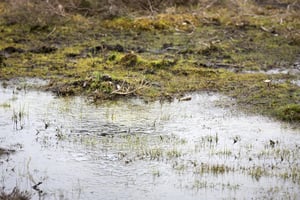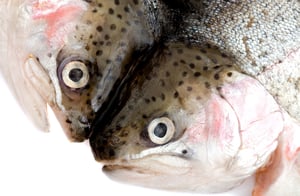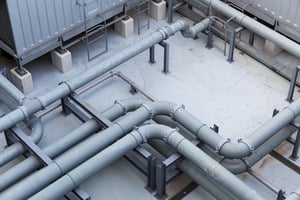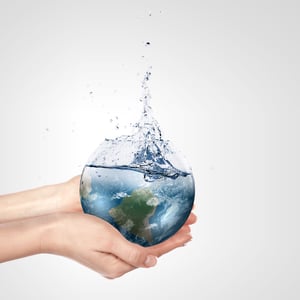Wastewater funnels from every corner of human habitation. From homes, human and household waste is washed away from toilets, sinks, baths and other drains.
Businesses and institutions such as medical facilities, pharmaceutical manufacturers, factories, food operations and even schools create water contaminated with chemicals and other waste. All of them depend on water for a huge variety of applications, and the vast majority of that water – 95 percent, in fact – swirls down the drain sooner or later.
So, wastewater is a product of our society, plain and simple.
What Exactly Is Wastewater?
 In elementary school, we learned about the Water Cycle. The glib circle of evaporation, condensation and precipitation made it seem as though water could “take care of itself” in an endless, self-sustaining loop.
In elementary school, we learned about the Water Cycle. The glib circle of evaporation, condensation and precipitation made it seem as though water could “take care of itself” in an endless, self-sustaining loop.
Unfortunately, that’s not the case. Water gets contaminated by homes and businesses, agricultural applications and the waves sheeting off of asphalt into storm drains.
That water does not clean itself or evaporate neatly away to rain down somewhere else later. Many of the chemicals and pollutants that enter water through factories, sewers and municipalities stay there.
The Impact of Wastewater
Yet perhaps because it has the word “water” in it, people tend to think of wastewater as a relatively harmless substance.
Think again.
The detergents, soaps and chemicals that flow from residences, businesses and agriculture can all do significant damage to the environment.
This is magnified hugely when the wastewater is coming from manufacturers or packing plants. Without proper disposal and treatment, the results of these pollutants can be extremely damaging. And, the impact on ecology can be irreversible … or at least exceedingly difficult to undo.
They include, but are not limited to:

- The death of marine mammals, fish and coral
- The poisoning of seabirds and destruction of habitat
- Toxic algae blooms and the resulting “dead zones” they create from using up all the oxygen in their vicinity
- Accumulation of toxins in animals higher up in the food chain, especially predators and humans
- Chemical accumulation in streams, rivers and aquifers
You can read more in our previous article, Chemical Waste and Impact on Aquatic Life or Water Quality.
One of the most serious impacts relates to drinking water. Fresh, clean water is quickly becoming the most precious commodity of our world.
According to Do Something, “768 million people lack access to improved drinking water supplies and 2.5 billion people – half of the developing world – lack access to adequate sanitation.”
Moreover, Americans consume 27 percent more water than we did in 1950. As we use more water every year, this problem only intensifies.
Proper Wastewater Solutions and Treatment
Without the technology put in place to recapture wastewater and process it, the impact will only get worse. Several solutions have been put in place to address this issue:
Wastewater Treatment Facilities
 The basic function of wastewater treatment is to speed up the natural processes by which water is purified.
The basic function of wastewater treatment is to speed up the natural processes by which water is purified.
There are two basic stages used in the treatment of wastewater:
Primary Treatment - solids are allowed to settle and then removed from wastewater.
- As sewage enters a plant for treatment, it flows through a screen, which removes large floating objects such as rags and sticks that might clog pipes or damage equipment.
- After sewage has been screened, it passes into a grit chamber, where cinders, sand, and small stones settle to the bottom.
- After screening is completed and grit has been removed, sewage still contains organic and inorganic matter along with other suspended solids. These solids are minute particles that can be removed from sewage in a sedimentation tank.
- When the speed of the flow through one of these tanks is reduced, the suspended solids will gradually sink to the bottom, where they form a mass of solids called raw primary biosolids (sludge).
- Biosolids are usually removed from tanks by pumping, after which it may be further treated for use as a fertilizer, or disposed of in a land fill or incinerated.
Secondary Treatment - biological processes are used to further purify wastewater.
- After it leaves the sedimentation tank in the primary stage it flows or is pumped to another facility. It goes to a trickling filter, which is simply a bed of stones (pieces of corrugated plastic or other synthetic media are sometimes used) from three to six feet deep through which sewage passes.
- Bacteria gather and multiply on these stones until they can consume most of the organic matter.
- The cleaner water trickles out through pipes for further treatment.
- From a trickling filter, the partially treated sewage flows to another sedimentation tank to remove excess bacteria.
Sometimes, these stages are combined into one operation.
 New Treatment Processes
New Treatment Processes
- The activated sludge process speeds up the work of the bacteria by bringing air and sludge heavily laden with bacteria into close contact with sewage.
- After the sewage leaves the settling tank in the primary stage, it is pumped into an aeration tank, where it is mixed with air and sludge loaded with bacteria and allowed to remain for several hours. During this time, the bacteria break down the organic matter into harmless by-products.
- The sludge, now activated with additional billions of bacteria and other tiny organisms, can be used again by returning it to the aeration tank for mixing with air and new sewage.
- From the aeration tank, the partially treated sewage flows to another sedimentation tank for removal of excess bacteria.
- To complete secondary treatment, it is brought from the sedimentation tank and usually disinfected with chlorine before being discharged into receiving waters.
- Chlorine is fed into the water to kill pathogenic bacteria, and to reduce odor. Done properly, chlorination will kill more than 99 percent of the harmful bacteria in an effluent.
According to the EPA, wastewater treatment facilities in the United States process approximately 34 billion gallons of wastewater every day.
Other Treatment Options
 New pollution problems have placed additional burdens on wastewater treatment systems. Today’s pollutants, such as heavy metals, chemical compounds, and toxic substances, are more difficult to remove from water.
New pollution problems have placed additional burdens on wastewater treatment systems. Today’s pollutants, such as heavy metals, chemical compounds, and toxic substances, are more difficult to remove from water.
Rising demands on the water supply only aggravate the problem. The increasing need to reuse water calls for better wastewater treatment. These challenges are being met through better methods of removing pollutants at treatment plants, or through prevention of pollution at the source.
Pre-treatment of industrial waste removes many troublesome pollutants at the beginning, not the end of the pipeline.
Hazardous waste disposal companies are contributing to this process by providing storm drain cleaning, tank cleaning and pump station cleaning. In addition, by educating customers and providing businesses hazardous waste disposal of chemicals and other pollutants, contaminated water can be minimized.
Wastewater treatment is essential to protect one of our most valuable natural resources. Scarcity and necessity have driven the advances in treatment of wastewater. If we all contribute to the process, we can ensure that there will be a sufficient supply of water, as well as protect our environment and the ecosystem.


Comment